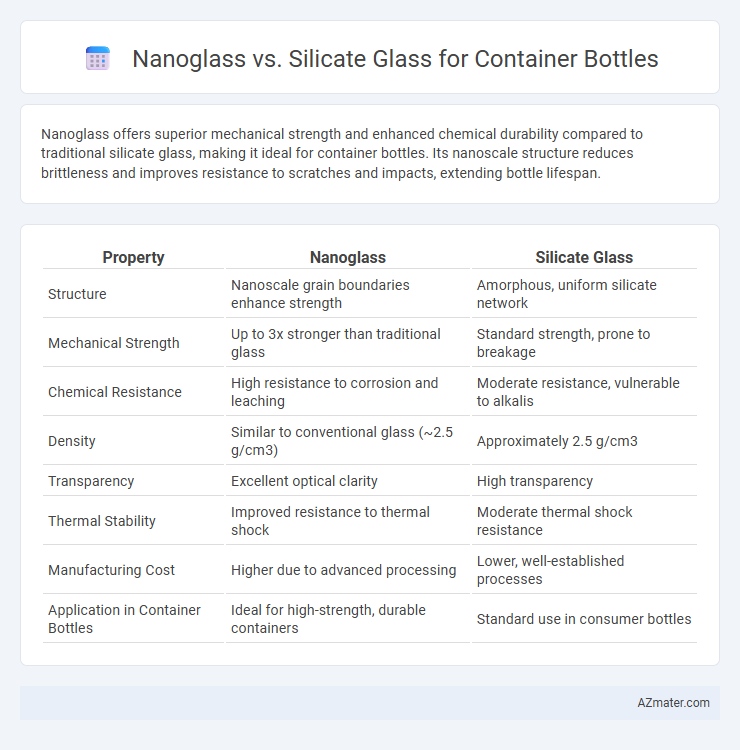Nanoglass offers superior mechanical strength and enhanced chemical durability compared to traditional silicate glass, making it ideal for container bottles. Its nanoscale structure reduces brittleness and improves resistance to scratches and impacts, extending bottle lifespan.
Table of Comparison
| Property | Nanoglass | Silicate Glass |
|---|---|---|
| Structure | Nanoscale grain boundaries enhance strength | Amorphous, uniform silicate network |
| Mechanical Strength | Up to 3x stronger than traditional glass | Standard strength, prone to breakage |
| Chemical Resistance | High resistance to corrosion and leaching | Moderate resistance, vulnerable to alkalis |
| Density | Similar to conventional glass (~2.5 g/cm3) | Approximately 2.5 g/cm3 |
| Transparency | Excellent optical clarity | High transparency |
| Thermal Stability | Improved resistance to thermal shock | Moderate thermal shock resistance |
| Manufacturing Cost | Higher due to advanced processing | Lower, well-established processes |
| Application in Container Bottles | Ideal for high-strength, durable containers | Standard use in consumer bottles |
Introduction: Comparing Nanoglass and Silicate Glass
Nanoglass offers enhanced strength and chemical durability compared to traditional silicate glass, making it a superior material for container bottles in terms of resistance to impact and corrosion. Silicate glass, composed primarily of silicon dioxide, provides excellent transparency and thermal stability but lacks the nano-engineered reinforcement that improves performance under stress. The comparison highlights Nanoglass's potential to extend the lifespan and safety of containers used in pharmaceuticals and beverages.
Material Composition of Nanoglass vs Silicate Glass
Nanoglass features a nanoscale structure with enhanced silica networks combined with doped metal oxides, resulting in superior strength and chemical resistance compared to conventional silicate glass. Silicate glass primarily consists of silicon dioxide (SiO2) with varying amounts of sodium oxide and calcium oxide, which impacts its durability and thermal stability. The unique material composition of nanoglass offers improved barrier properties and resistance to fracturing, making it a superior choice for container bottles in demanding storage environments.
Manufacturing Processes: Nanoglass vs Silicate Glass
Nanoglass manufacturing involves advanced sol-gel techniques and nanoparticle reinforcement to enhance strength and transparency, resulting in improved durability for container bottles. Silicate glass production relies on traditional melting and cooling processes of silica sand and additives, offering established scalability but limited strength compared to nanoglass. The precise control in nanoglass synthesis enables superior resistance to thermal shock and chemical corrosion, making it a more innovative choice for high-performance bottle applications.
Mechanical Strength and Durability
Nanoglass exhibits superior mechanical strength compared to traditional silicate glass, owing to its nanoscale microstructure that enhances resistance to cracks and impacts. The durability of nanoglass containers surpasses silicate glass by offering improved thermal stability and reduced brittleness, leading to longer lifespan under varying environmental conditions. Its enhanced fracture toughness and higher hardness make nanoglass the preferred choice for container bottles requiring robust performance and reliability.
Chemical Resistance and Longevity
Nanoglass exhibits superior chemical resistance compared to conventional silicate glass, effectively withstanding aggressive substances and minimizing leaching in container bottles. Its enhanced molecular structure results in greater durability and longevity, reducing the risk of degradation and extending product shelf life. Silicate glass, while widely used, is more susceptible to surface corrosion and chemical attack, which can compromise container integrity over time.
Transparency and Optical Properties
Nanoglass exhibits superior transparency compared to traditional silicate glass due to its nanoscale structure, which minimizes light scattering and enhances clarity. The optical properties of nanoglass include higher refractive index homogeneity and reduced chromatic aberration, offering clearer and more vibrant visual presentation in container bottles. Silicate glass, while durable, often has microstructural inconsistencies that slightly diminish its optical performance relative to nanoglass.
Environmental Impact and Sustainability
Nanoglass offers superior environmental benefits compared to traditional silicate glass due to its enhanced recyclability and lower energy consumption during production, reducing carbon emissions significantly. The nanostructured coating in Nanoglass increases durability and resistance to contaminants, extending the container bottle's lifespan and minimizing waste. Silicate glass, while recyclable, requires higher melting temperatures and more raw materials, resulting in a larger environmental footprint and less sustainable lifecycle.
Cost Efficiency and Economic Considerations
Nanoglass offers significant cost efficiency over silicate glass for container bottles due to its lower manufacturing energy consumption and reduced material waste, resulting in decreased production costs. Economic considerations favor nanoglass as it enhances durability and lightweight properties, leading to savings in transportation and handling expenses. The higher initial investment in nanoscale coating technology for nanoglass is offset by long-term benefits including extended bottle lifespan and improved recycling potential compared to traditional silicate glass.
Applications in Container Bottle Industry
Nanoglass offers enhanced barrier properties and superior strength compared to conventional silicate glass, making it ideal for high-performance container bottles in the beverage and pharmaceutical industries. Its nanoscale structure provides improved chemical resistance and reduced permeability, ensuring better preservation of contents and longer shelf life. Silicate glass remains popular for cost-effective, transparent containers but lacks the advanced durability and protective features of nanoglass-based bottles.
Conclusion: Choosing the Right Glass for Bottles
Nanoglass offers superior strength, scratch resistance, and chemical durability compared to traditional silicate glass, making it ideal for high-performance container bottles requiring enhanced protection and longevity. Silicate glass remains a cost-effective and widely used material, suitable for standard applications where affordability and recyclability are priorities. Selecting the right glass depends on balancing performance needs with budget constraints and environmental considerations.

Infographic: Nanoglass vs Silicate glass for Container bottle
 azmater.com
azmater.com